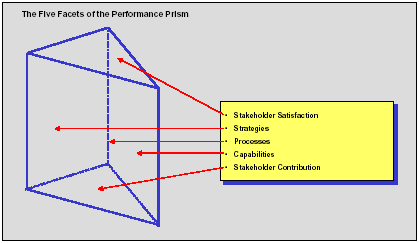
Measuring Stakeholder Value

 |
Measuring Stakeholder Value |
 |
|
Articles | Books | Dictionary | Faq | Home | Leaders | Organizations | Search
|
Performance Prism |
Summary of the Performance Prism. Abstract |
Cranfield University |
 The Performance Prism
(Cranfield University)
is an innovative second generation performance measurement and management
framework. Its advantage over other frameworks is that it addresses
all of an organisation’s stakeholders - principally investors,
customers & intermediaries, employees, suppliers, regulators and
communities. It does this in two ways: by considering what the wants and
needs are of the stakeholders are and, uniquely, what the
organisation wants and needs from its stakeholders. In
this way, the reciprocal relationship with each stakeholder is examined.
The Performance Prism
(Cranfield University)
is an innovative second generation performance measurement and management
framework. Its advantage over other frameworks is that it addresses
all of an organisation’s stakeholders - principally investors,
customers & intermediaries, employees, suppliers, regulators and
communities. It does this in two ways: by considering what the wants and
needs are of the stakeholders are and, uniquely, what the
organisation wants and needs from its stakeholders. In
this way, the reciprocal relationship with each stakeholder is examined.

The five facets of the Performance Prism:
1. Stakeholder Satisfaction
2. Stakeholder Contribution
3. Strategies
4. Processes
5. Capabilities
These five perspectives are distinct, but logically interlinked.
Philosophy
The Performance Prism is based on
the belief that those organisations aspiring to be successful in the
long term within today’s business environment have an exceptionally
clear picture of who their key stakeholders are and what they want.
They have defined what strategies they will pursue to ensure that value
is delivered to these
stakeholders. They understand what processes the enterprise requires if
these strategies are to be
delivered and they have defined what capabilities they need to execute
these processes. The most
sophisticated of them have also thought carefully about what it is that
the organisation wants from its
stakeholders – employee loyalty, customer profitability, long term
investments, etc. In essence they
have a clear business model and an explicit understanding of what
constitutes and drives good
performance.
Approach: Starting with Stakeholders, not with Strategy
According to Performance Prism vision, one of the great fallacies of performance measurement is that measures should be derived from strategy. Listen to any conference speaker on the subject. Read any management text written about it. Nine times out of ten the statement will be made – “derive your measures from your strategy”. This is such a conceptually appealing notion, that nobody stops to question it. Yet to derive measures from strategy is to misunderstand fundamentally the purpose of measurement and the role of strategy. That's why the Performance Prism starts its process with thinking about the Stakeholders and what they want.
Five key questions for measurement design:
1. Stakeholder Satisfaction – who are
the key stakeholders and what do they want and need?
2. Strategies – what strategies do we have to put in place to satisfy
the wants and needs of these key
stakeholders?
3. Processes – what critical processes do we require if we are to
execute these strategies?
4. Capabilities – what capabilities do we need to operate and enhance
these processes?
5. Stakeholder Contribution – what contributions do we require from our
stakeholders if we are to
maintain and develop these capabilities?
Complexity and the Prism
The history of Value Based Management is basically a history of increasing complexity. A prism refracts light. It illustrates the hidden complexity of something as apparently simple as white light and decomposes it in its elements. So it is with the Performance Prism. It illustrates the hidden complexity of our corporate world. Single dimensional, traditional frameworks pick up elements of this complexity. While each of them offers a unique perspective on performance, it is essential to recognise that this is all that they offer – a single uni-dimensional perspective on performance. Performance, however, is not uni-dimensional. To understand it in its entirety, it is essential to view from the multiple and interlinked perspectives offered by the Performance Prism.
| 👀 | TIP: To learn more, have a look at the erformance Prism center: Summary, forum, tips and tools. |
Compare: Balanced Scorecard | Strategy Maps | Value Mapping | The Strategy- Focused Organization | Intangible Assets Monitor | IC Rating
About us | Advertise | Privacy | Support us | Terms of Service
©2025 Value Based Management.net - All names tm by their owners